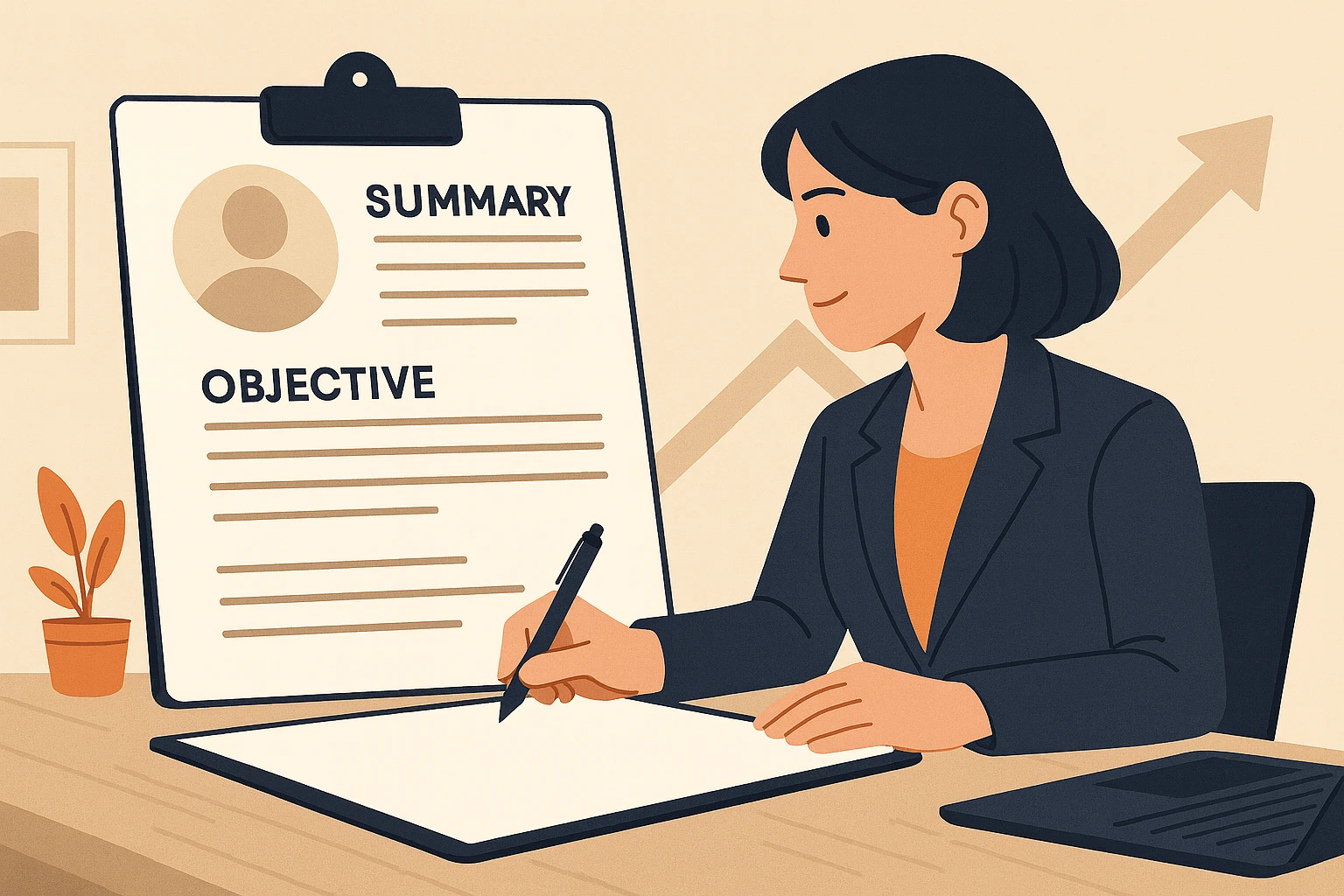Changing careers is never just about updating a job title—it’s about rewriting your professional story in a way that makes sense to a new audience. For many career changers, the toughest part isn’t the lack of ability, but the challenge of proving relevance on paper. Hiring managers scan resumes quickly, and applicant tracking systems (ATS) filter even faster. If the opening lines of your resume don’t clearly connect your past experience with your future direction, your application may never get a second look.
That’s why the resume summary for career change or the career change resume objective matters so much. Done well, it shows hiring managers that you’re not just drifting into a new field—you’re bringing transferable skills, fresh perspective, and genuine motivation. It gives you the chance to control the narrative before anyone else does.
In this guide, you’ll find:
- A clear explanation of what a resume summary and resume objective are—and the difference between them.
- Dozens of real, copy-ready examples tailored to different industries.
- Practical tips for highlighting transferable skills and tailoring your message to a new role.
- A decision framework to help you choose between a summary and an objective.
- FAQs that address the most common concerns career changers face.
By the end, you’ll have a toolkit of examples and strategies to position yourself with confidence, even if you’re entering an entirely new field.
What Is a Resume Summary?
A resume summary is a short snapshot—two to four sentences—that highlights your experience, transferable skills, and achievements. Unlike a resume objective, which looks forward to your career goals, a summary looks back at what you’ve already done and reframes it for the role you want next.
For career changers, the resume summary is especially powerful. It allows you to take the strongest parts of your past career and translate them into the language of your new industry. Instead of leaving hiring managers guessing how your background fits, the summary makes the connection clear.
When to Use a Resume Summary in a Career Change
A summary is best when you:
- Already have several years of professional experience.
- Can point to achievements that are transferable across industries.
- Want to show credibility and adaptability from the start.
Resume Summary Examples for Career Changers
Example 1: Teacher → Human Resources
“Former high school teacher with 8+ years of experience in training, mentoring, and conflict resolution. Skilled at developing people-focused programs and fostering positive workplace culture. Transitioning into HR to apply proven leadership and communication expertise to employee engagement and development.”
Example 2: Military → Project Management
“Veteran with 10 years of leadership experience managing teams in high-pressure environments. Adept at logistics, planning, and cross-functional coordination. Pursuing a career in project management to leverage discipline, strategic thinking, and operational excellence.”
Example 3: Retail → IT Support
“Customer-focused retail associate with 6 years of experience solving problems and building client relationships. Known for technical troubleshooting skills and adaptability in fast-paced environments. Seeking to bring strong communication and tech-savvy mindset to an IT support role.”
Example 4: Hospitality → Administrative Assistant
“Hospitality professional with 5+ years in front-office operations, scheduling, and client service. Recognized for organizational skills and attention to detail. Transitioning to administrative support to deliver seamless coordination and professional communication in an office setting.”
Example 5: Finance → Data Analyst
“Finance professional with 7+ years of experience interpreting complex datasets, creating reports, and advising on investment strategies. Skilled in Excel, SQL, and data visualization. Transitioning to data analysis to apply quantitative expertise and business acumen in driving insights and decision-making.”
Example 6: Journalist → Content Marketing
“Former journalist with 5 years of experience researching, writing, and editing engaging stories for digital audiences. Adept at SEO, audience engagement, and brand storytelling. Looking to bring creative communication and content strategy skills to a marketing team.”
Example 7: Sales → Healthcare Administration
“Sales manager with a decade of experience leading teams, building client relationships, and streamlining operations. Known for organizational efficiency and people management. Transitioning into healthcare administration to combine operational skills with a passion for patient-centered service.”
Example 8: Accountant → Business Analyst
“Detail-oriented accountant with 6 years of experience in financial reporting, compliance, and process improvement. Proficient in identifying inefficiencies and recommending solutions. Moving into business analysis to apply analytical skills and problem-solving in a broader strategic role.”
Example 9: Graphic Designer → UX Designer
“Creative professional with 8 years of experience in visual design, branding, and digital media. Skilled at understanding user needs and translating them into engaging visuals. Pursuing UX design to combine design expertise with user research and product development.”
Example 10: Nurse → Health Tech Specialist
“Registered nurse with 7 years of patient care experience and strong knowledge of healthcare workflows. Experienced in using EMR systems and training staff on digital tools. Transitioning to health tech to improve systems that empower healthcare providers and patients.”
Why These Examples Work
Each summary translates the old role into the requirements of the new one. The emphasis is not on job titles but on transferable skills—leadership, organization, communication, adaptability—that make sense in the new context. This is the key to writing a strong resume summary for career change: you connect the dots for the recruiter so they don’t have to.
Ready to Land Your Next Job?
Don’t let your resume get lost in the stack. Build a professional, ATS-friendly resume that highlights your leadership, achievements, and industry expertise.
What Is a Resume Objective?
A resume objective is a short statement (usually 2–3 lines) that highlights your career goals and motivation for applying. Unlike a resume summary, which focuses on past experience, an objective looks forward—it explains what you want to do next and why you’re a good fit for that path.
For career changers, a resume objective is useful when you don’t yet have direct experience in the new field. It lets you show enthusiasm, commitment, and transferable skills, your certifications relevant to job you are applying even if your job titles don’t match the role you’re applying for.
When to Use a Resume Objective in a Career Change
A resume objective is best when you:
- Are making a big pivot into a completely new field.
- Have limited work experience (e.g., recent graduates, returning to work).
- Want to highlight motivation and direction rather than past titles.
Resume Objective Examples for Career Changers
Example 1: Customer Service → Marketing
“Motivated customer service professional eager to transition into marketing. Skilled in communication, relationship-building, and problem-solving, with a passion for creating campaigns that connect with audiences.”
Example 2: Engineer → Data Analyst
“Detail-oriented engineer transitioning into data analytics. Proficient in Excel, Python, and statistical analysis with a strong ability to interpret technical data and deliver actionable insights.”
Example 3: Nurse → Teaching
“Compassionate registered nurse seeking to apply 6 years of healthcare experience in a teaching role. Adept at explaining complex concepts clearly and fostering supportive learning environments.”
Example 4: Retail Associate → Office Administration
“Organized retail associate pursuing a career in office administration. Experienced in scheduling, customer interaction, and multitasking in fast-paced settings. Excited to contribute efficiency and professionalism to a growing team.”
Example 5: Stay-at-Home Parent → Human Resources
“Dedicated professional returning to the workforce with a focus on human resources. Skilled in conflict resolution, time management, and mentoring, with a strong commitment to supporting employees and workplace culture.”
Example 6: Hospitality → Event Planning
“Hospitality specialist aiming to transition into event planning. Experienced in client service, vendor coordination, and managing high-pressure situations to deliver seamless guest experiences.”
Example 7: Teacher → Instructional Designer
“Educator passionate about learning technologies, seeking to shift into instructional design. Skilled in curriculum development, e-learning tools, and creating engaging educational content.”
Example 8: Military → Logistics Coordinator
“Veteran transitioning into civilian logistics operations. Proven ability to manage supply chains, coordinate teams, and meet critical deadlines under pressure.”
Example 9: Journalist → Corporate Communications
“Former journalist pursuing a career in corporate communications. Strong writing, editing, and storytelling skills with experience engaging diverse audiences through clear, persuasive messaging.”
Example 10: Sales → Digital Marketing
“Results-driven sales professional eager to move into digital marketing. Experienced in client outreach, market research, and persuasion. Seeking to apply customer insights and creativity to online campaigns.”
Resume Summary vs. Resume Objective: Which One Should You Use?
Both the resume summary and the resume objective serve as the opening pitch of your resume, but they’re designed for different situations. Choosing the right one is crucial—use the wrong approach, and you risk either underselling your achievements or sounding too vague about your direction.
Key Differences at a Glance
| Feature | Resume Summary | Resume Objective |
|---|---|---|
| Focus | Highlights your past achievements, skills, and experience | Highlights your career goals, motivation, and direction |
| Best For | Experienced professionals with transferable skills | Career changers with little/no direct experience |
| Tone | Authoritative and achievement-driven | Aspirational and forward-looking |
| Keywords | Emphasizes skills and accomplishments relevant to new field | Emphasizes enthusiasm, growth mindset, and career pivot |
| Length | 2–4 lines | 2–3 lines |
How to Decide
- Use a resume summary if you already have achievements, transferable skills, or relevant experience that can be reframed for your new field.
- Use a resume objective if you’re entering a completely new industry, have limited professional history, or want to emphasize passion and direction over past roles.
Think of it this way:
- If your past work already speaks to your new career, write a summary.
- If your past work doesn’t yet align and you need to show intention, write an objective.
How to Write a Strong Career Change Resume Summary/Objective
Writing a resume summary or objective as a career changer is less about rewriting your past and more about reframing it for the future. Hiring managers don’t expect you to have the perfect background—they expect you to show clarity, motivation, and skills that translate. Here’s how to do it right:
1. Mirror the Job Description
Every role has a blueprint hidden in its posting. Pay attention to the repeated keywords—whether it’s “project coordination,” “team leadership,” or “client communication.” Use those words in your resume summary or objective so that both ATS systems and human reviewers immediately see the match. Think of it as speaking the employer’s language.
2. Highlight Transferable Skills
Don’t waste space apologizing for what you lack. Instead, showcase the skills you’ve already proven in other industries: leadership, communication, organization, customer service, data analysis, or problem-solving. These are the building blocks that employers in any field trust. By putting them front and center, you shift the conversation from “no direct experience” to “valuable experience in a different context.”
3. Show Adaptability Through Achievements
Hiring managers want proof that you can thrive outside your comfort zone. Mention a concrete achievement that demonstrates flexibility—like leading a team during a major transition, mastering a new digital tool, or handling responsibilities outside your formal role. These stories reassure employers that you can step into their world and get up to speed quickly.
4. Keep It Concise
Your summary or objective should be punchy—no more than two to four lines. It’s not your life story; it’s your pitch. Think of it as a movie trailer: intriguing enough to make someone want to see the full story (your resume), but tight enough to hold attention in a ten-second skim.
Example Rewrite: Weak vs. Strong Career-Change Statement
Generic (Weak):
“Looking for a job in marketing where I can use my communication skills and grow professionally.”
Strong (Career Change-Ready):
“Customer service professional with 5+ years of experience in client communication and problem-solving. Seeking to transition into marketing, bringing proven skills in relationship-building, persuasive communication, and data-driven decision-making.”
The second version works because it:
- Shows transferable skills.
- Uses employer-friendly language.
- Clearly states direction (career change into marketing).
Ready to Land Your Next Job?
Don’t let your resume get lost in the stack. Build a professional, ATS-friendly resume that highlights your leadership, achievements, and industry expertise.
Extra Tips for Career Changers
Emphasize Transferable Skills
Your previous industry may look different on the surface, but the skills you built there still count. Leadership, problem-solving, teamwork, organization, and communication are all highly valued across fields. By presenting them upfront, you make it clear that your background has weight and relevance.
Show Evidence of Learning
Career changers stand out when they can prove they’re actively building expertise. Adding certifications, online courses, or workshops in your new field shows initiative. Even a short course on platforms like Coursera, LinkedIn Learning, or Google can tip the scales by demonstrating commitment.
Use Volunteer or Freelance Experience
If you’ve applied your skills through volunteering, freelance projects, or side work, include it in your resume. These experiences are evidence that you’ve already tested your abilities in the new field, and they show employers that you’re willing to put in the work before getting the official title.
Demonstrate Passion for the Field
Hiring managers want to know you’re not switching careers on a whim. Use your summary, objective, or cover letter for career change to briefly express why this new field excites you. Genuine enthusiasm—backed by preparation—helps frame you as a motivated candidate rather than someone uncertain.
Leverage Hybrid Experiences
Often, parts of your past job overlapped with the skills your target role requires. For example, a teacher who introduced new software at school or a retail associate who managed inventory systems. Highlighting these hybrid experiences helps bridge the gap and makes the transition appear more natural.
Keep the Tone Confident
Avoid phrases that draw attention to what you lack, such as “though I have no experience” or “looking to start fresh.” Instead, focus on what you bring. A confident tone signals to employers that you believe in your value—and that makes them more likely to believe in it too.
Also Read:- Summary For Resume For Fresher
Conclusion
Changing careers is always a leap—but it’s one that employers respect when it’s presented with clarity and purpose. A well-written resume summary for career change or a strong career change resume objective helps reframe your background as an asset rather than a mismatch. Instead of making recruiters guess how your past fits into your future, you show them the connection directly.
Remember: adaptability and transferable skills often matter more than a perfect career history. If you can highlight what you’ve learned, demonstrate commitment to your new path, and craft a clear narrative at the top of your resume, you’ll position yourself as a confident candidate ready for the next chapter of your career.
Also read:- Why Do You think You are suitable for this job – Fresher’s Answer
FAQs(People Also Asked)
The best resume summary for a career change is one that takes your past achievements and reframes them for the new field. Instead of listing job titles, focus on transferable skills like leadership, communication, organization, or data analysis. For example, a teacher moving into HR might highlight mentoring, training, and conflict resolution experience. The key is to connect the dots for the employer so they instantly see your relevance.
When writing an objective for a career change resume, keep it forward-looking. State your career goal clearly, show enthusiasm for the new field, and include one or two transferable skills that will make you valuable. For instance: “Customer service professional seeking to transition into marketing, bringing proven strengths in communication, problem-solving, and audience engagement.” The emphasis should be on motivation and potential rather than experience.
It depends on your background and the strength of your transferable achievements. If you already have professional accomplishments that align with the new field, a summary works better because it highlights credibility. If you lack direct experience or are making a dramatic pivot, an objective is often the stronger choice because it conveys direction and enthusiasm.
You can highlight transferable skills by weaving them into your summary, objective, and work experience descriptions. Instead of simply listing tasks, explain outcomes that demonstrate universal strengths—such as leading a team, solving complex problems, or managing clients. Pair these with industry keywords from the job description to make your resume ATS-friendly and compelling to human readers.
Yes—employers often hire career changers if they show commitment and transferable value. Courses, certifications, volunteer work, or side projects can help bridge the gap. What matters most is that your resume tells a coherent story: you have skills that matter, motivation to adapt, and proof that you can apply yourself in new contexts. A strong resume summary or objective is the first step in shaping that narrative.







